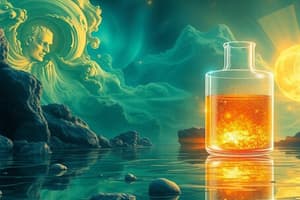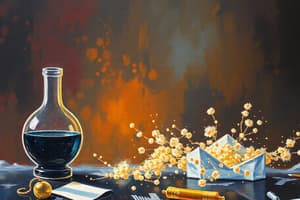Podcast
Questions and Answers
What occurs in a state of dynamic equilibrium?
What occurs in a state of dynamic equilibrium?
- Products completely convert to reactants.
- Only reactants are present.
- The concentration of products decreases over time.
- The rate of the forward reaction equals the rate of the backward reaction. (correct)
How does Le Chatelier's Principle apply when stress is applied to a system at equilibrium?
How does Le Chatelier's Principle apply when stress is applied to a system at equilibrium?
- The rate of the forward reaction permanently increases.
- The system adjusts to relieve the stress imposed. (correct)
- The system adjusts to favor the side that increases the number of molecules.
- The equilibrium position will not change.
What effect does increasing pressure have on a gaseous reaction with unequal numbers of reactants and products?
What effect does increasing pressure have on a gaseous reaction with unequal numbers of reactants and products?
- It favors the side with the larger number of molecules.
- It changes the direction of the backward reaction.
- It has no effect on the reaction.
- It favors the side with the smaller number of molecules. (correct)
In a reversible reaction under dynamic equilibrium, how are the concentrations of reactants and products affected?
In a reversible reaction under dynamic equilibrium, how are the concentrations of reactants and products affected?
What is characterized as a stress in the context of Le Chatelier's Principle?
What is characterized as a stress in the context of Le Chatelier's Principle?
Which of the following statements about exothermic and endothermic reactions is true?
Which of the following statements about exothermic and endothermic reactions is true?
What is the effect of a catalyst on a reaction at equilibrium?
What is the effect of a catalyst on a reaction at equilibrium?
What happens to the volume of a system when pressure is increased in an equilibrium reaction with unequal gaseous molecules?
What happens to the volume of a system when pressure is increased in an equilibrium reaction with unequal gaseous molecules?
What is the main purpose of the Haber process?
What is the main purpose of the Haber process?
Which conditions are best for maximizing ammonia yield in the Haber process according to Le Chatelier's Principle?
Which conditions are best for maximizing ammonia yield in the Haber process according to Le Chatelier's Principle?
What is the equilibrium constant Kc used to represent?
What is the equilibrium constant Kc used to represent?
In the reaction 2SO2(g) + O2(g) ↔ 2SO~3, what is the effect of increasing the pressure?
In the reaction 2SO2(g) + O2(g) ↔ 2SO~3, what is the effect of increasing the pressure?
What is the role of the catalyst in the Contact Process for sulfuric acid production?
What is the role of the catalyst in the Contact Process for sulfuric acid production?
What is the effect on the concentration of PCl5 when more PCl3 is introduced into the equilibrium mixture?
What is the effect on the concentration of PCl5 when more PCl3 is introduced into the equilibrium mixture?
What is the heat change (ΔH) for the synthesis of ammonia from nitrogen and hydrogen?
What is the heat change (ΔH) for the synthesis of ammonia from nitrogen and hydrogen?
How does an increase in pressure affect the equilibrium of the reaction involving PCl3 and Cl2?
How does an increase in pressure affect the equilibrium of the reaction involving PCl3 and Cl2?
What is the best temperature for the catalyst to work in the Contact Process?
What is the best temperature for the catalyst to work in the Contact Process?
What happens to the concentration of PCl5 if the temperature of the reaction increases?
What happens to the concentration of PCl5 if the temperature of the reaction increases?
Calculate the equilibrium constant Kc using the given moles of each component at equilibrium: N2 = 13.6 moles, H2 = 1.0 mole, NH~3 = 1.5 moles.
Calculate the equilibrium constant Kc using the given moles of each component at equilibrium: N2 = 13.6 moles, H2 = 1.0 mole, NH~3 = 1.5 moles.
What occurs when concentrated hydrochloric acid is added to the red complex solution of Fe^3+^ and CNS^-?
What occurs when concentrated hydrochloric acid is added to the red complex solution of Fe^3+^ and CNS^-?
In the experiment, what is indicated if adding potassium thiocyanate solution causes the red complex to reform?
In the experiment, what is indicated if adding potassium thiocyanate solution causes the red complex to reform?
Which principle explains the color change when concentrated hydrochloric acid is added to the iron(III) chloride and potassium thiocyanate solution?
Which principle explains the color change when concentrated hydrochloric acid is added to the iron(III) chloride and potassium thiocyanate solution?
Why is ammonia considered an important chemical manufactured by the chemical industry?
Why is ammonia considered an important chemical manufactured by the chemical industry?
What does the term 'exothermic' mean in the context of the forward reaction?
What does the term 'exothermic' mean in the context of the forward reaction?
What is the change in the concentration of Fe^3+ when KCNS is added to the equilibrium mixture?
What is the change in the concentration of Fe^3+ when KCNS is added to the equilibrium mixture?
Why does changing the pressure have no effect on the equilibrium established in the reaction of iron(III) chloride and potassium thiocyanate?
Why does changing the pressure have no effect on the equilibrium established in the reaction of iron(III) chloride and potassium thiocyanate?
Calculate the equilibrium constant (Kc) for the reaction knowing that at equilibrium, 1.1 × 10^-4 moles of Fe(CNS)2+ are present in a 1-litre solution.
Calculate the equilibrium constant (Kc) for the reaction knowing that at equilibrium, 1.1 × 10^-4 moles of Fe(CNS)2+ are present in a 1-litre solution.
What happens to the value of Kc for the reaction when the temperature is decreased?
What happens to the value of Kc for the reaction when the temperature is decreased?
Which of the following describes the nature of the forward reaction of the iron(III) chloride and potassium thiocyanate system?
Which of the following describes the nature of the forward reaction of the iron(III) chloride and potassium thiocyanate system?
What is the equilibrium constant expression for the decomposition of 2NO into N2 and O2?
What is the equilibrium constant expression for the decomposition of 2NO into N2 and O2?
Given the equilibrium constant (Kc) of 20.25, what value does x equal after solving the equation related to the equilibrium of the reaction?
Given the equilibrium constant (Kc) of 20.25, what value does x equal after solving the equation related to the equilibrium of the reaction?
How does an increase in temperature affect the equilibrium state of an exothermic reaction?
How does an increase in temperature affect the equilibrium state of an exothermic reaction?
Which statement correctly describes Le Châtelier's principle?
Which statement correctly describes Le Châtelier's principle?
Which of the following substances is known to 'poison' the catalysts in a catalytic converter?
Which of the following substances is known to 'poison' the catalysts in a catalytic converter?
What type of catalysis occurs in catalytic converters?
What type of catalysis occurs in catalytic converters?
What effect does an increase in pressure have on the value of Kc for a chemical reaction at equilibrium?
What effect does an increase in pressure have on the value of Kc for a chemical reaction at equilibrium?
What is meant by a dynamic chemical equilibrium?
What is meant by a dynamic chemical equilibrium?
Flashcards
Chemical Equilibrium
Chemical Equilibrium
A state where the forward and backward reaction rates are equal, resulting in constant reactant and product concentrations.
Reversible Reaction
Reversible Reaction
A chemical reaction where products can react to reform the original reactants.
Le Chatelier's Principle
Le Chatelier's Principle
When a stress is applied to a system in equilibrium, the system shifts to relieve the stress.
Stress (Le Chatelier's)
Stress (Le Chatelier's)
Signup and view all the flashcards
Pressure Effect (Gases)
Pressure Effect (Gases)
Signup and view all the flashcards
Catalyst
Catalyst
Signup and view all the flashcards
Exothermic Reaction
Exothermic Reaction
Signup and view all the flashcards
Endothermic Reaction
Endothermic Reaction
Signup and view all the flashcards
Shifting Equilibrium
Shifting Equilibrium
Signup and view all the flashcards
Adding Reactant
Adding Reactant
Signup and view all the flashcards
Increasing Pressure (Gases)
Increasing Pressure (Gases)
Signup and view all the flashcards
Raising Temperature (Exothermic)
Raising Temperature (Exothermic)
Signup and view all the flashcards
Shifting Equilibrium (Experiment)
Shifting Equilibrium (Experiment)
Signup and view all the flashcards
Removing a Product
Removing a Product
Signup and view all the flashcards
Haber Process (Ammonia)
Haber Process (Ammonia)
Signup and view all the flashcards
Le Chatelier's Principle (General)
Le Chatelier's Principle (General)
Signup and view all the flashcards
Equilibrium Constant (Kc)
Equilibrium Constant (Kc)
Signup and view all the flashcards
Kc Expression
Kc Expression
Signup and view all the flashcards
Calculating Kc
Calculating Kc
Signup and view all the flashcards
Temperature Effect on Kc
Temperature Effect on Kc
Signup and view all the flashcards
Catalytic Converter
Catalytic Converter
Signup and view all the flashcards
Heterogeneous Catalysis
Heterogeneous Catalysis
Signup and view all the flashcards
Haber Process
Haber Process
Signup and view all the flashcards
What is the role of the catalyst in the Haber Process?
What is the role of the catalyst in the Haber Process?
Signup and view all the flashcards
Le Chatelier's Principle and Ammonia Production
Le Chatelier's Principle and Ammonia Production
Signup and view all the flashcards
Contact Process
Contact Process
Signup and view all the flashcards
Optimal Conditions for Contact Process
Optimal Conditions for Contact Process
Signup and view all the flashcards
Equilibrium Constant Formula
Equilibrium Constant Formula
Signup and view all the flashcards
Calculating Kc: Example
Calculating Kc: Example
Signup and view all the flashcards
Effect of Adding KCNS
Effect of Adding KCNS
Signup and view all the flashcards
Pressure Effect on Equilibrium
Pressure Effect on Equilibrium
Signup and view all the flashcards
Effect of Temperature on Equilibrium
Effect of Temperature on Equilibrium
Signup and view all the flashcards
Study Notes
Chemical Equilibrium
- Definition: A state of dynamic balance in a reversible reaction where the rate of the forward reaction equals the rate of the backward reaction.
- Reversible Reaction: A reaction where products can react to reform reactants.
- Dynamic State: Reactants continuously form products, and products continuously form reactants.
Le Chatelier's Principle
- Definition: If a stress is applied to a system at equilibrium, the system readjusts to relieve the stress.
- Stress: Changes in reaction conditions (e.g., concentration, pressure, temperature).
Effect of Change of Pressure on Reactions Involving Gases
- Pressure Increase: Favors the reaction with a smaller number of molecules. This is because the smaller volume side reduces the pressure.
- Unequal Number of Gaseous Reactants and Products: Only affects reactions with an unequal number of gaseous products and reactants
Equilibrium Constants
- Definition: A constant that represents the relationship between the concentrations of reactants and products at equilibrium.
- Kc: Equilibrium constant expression.
Other Important Definitions
- ΔH: Enthalpy change, indicating whether a reaction is exothermic (heat given out) ΔH (-) or endothermic (heat taken in) ΔH (+)
Industrial Applications
- Haber-Bosch Process (Ammonia Production): High pressure and low temperature maximise ammonia yield.
- Contact Process (Sulfuric Acid Production): 450°C is the ideal temperature for the catalyst to work. Atmospheric pressure is generally used.
Experiment: Iron (III) Chloride and Potassium Thiocyanate
- Mixing iron (III) chloride and potassium thiocyanate creates a red complex.
- Addition of hydrochloric acid shifts the equilibrium to the left, decreasing the red colour.
- Adding more thiocyanate shifts equilibrium to the right, increasing the red colour.
Exam Question (Example)
- Equilibrium Constant (Kc) Expression: The ratio of product concentrations (raised to the power of their coefficients) to reactant concentrations.
- Effect of Temperature on Kc: No effect of pressure on equilibrium constant.
Studying That Suits You
Use AI to generate personalized quizzes and flashcards to suit your learning preferences.




